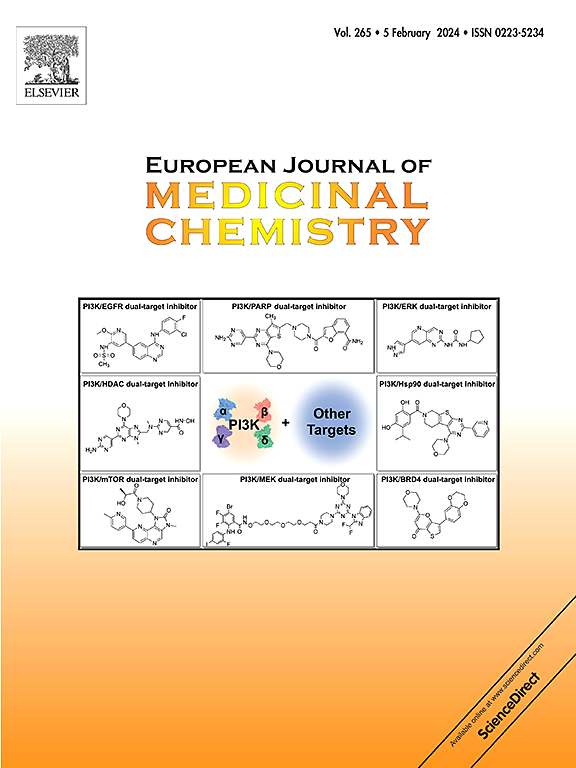AR-A014418-based dual Glycogen Synthase Kinase 3β/Histone Deacetylase inhibitors as potential therapeutics for Alzheimer's disease
IF 5.9
2区 医学
Q1 CHEMISTRY, MEDICINAL
引用次数: 0
Abstract
Alzheimer's disease (AD), the most common type of dementia, currently represents an unmet medical need worldwide. It is considered the result of a systemic breakdown of multiple physiological networks which might be adequately tackled by multitarget drugs (MTDs) aimed at restoring the perturbed networks. Accumulating evidence suggests that Glycogen Synthase Kinase 3β (GSK-3β) and Histone Deacetylases (HDACs) synergistically contribute to disease pathogenesis. In a continuation of our efforts to develop MTDs for AD, we manipulated the structure of a previously reported GSK-3β inhibitor, AR-A014418, to develop a new class of dual GSK-3β/HDACs binding agents. Among the 34 synthesized derivatives, compound 19 showed encouraging results, inhibiting GSK-3β (IC50 = 0.04 ± 0.01 μM) HDAC2 (IC50 = 1.05 ± 0.11 μM), and HDAC6 (IC50 = 1.52 ± 0.06 μM). In addition, compound 19 inhibits HDAC2 and 6 activities in cells and blocks tau hyperphosphorylation. Interestingly, it is nontoxic in SH-SY5Y cells up to 100 μM, and exerts neuroprotective effects. Moreover, to better elucidate the mode of action of compound 19, its effects on the molecular pathways of SH-SY5Y cells were studied using a proteome-wide analysis. We uncovered the potential of compound 19, which represents a promising hit for the development of innovative disease-modifying agents.


基于ar - a014418的双糖原合成酶激酶3β /组蛋白去乙酰化酶抑制剂作为阿尔茨海默病的潜在治疗药物
阿尔茨海默病(AD)是最常见的痴呆症类型,目前在世界范围内是一个未满足的医疗需求。它被认为是多个生理网络系统崩溃的结果,可以通过旨在恢复受干扰网络的多靶点药物(MTDs)充分解决。越来越多的证据表明糖原合成酶激酶3β (GSK-3β)和组蛋白去乙酰化酶(hdac)协同参与疾病的发病机制。为了继续开发针对AD的MTDs,我们操纵了先前报道的GSK-3β抑制剂AR-A014418的结构,以开发一类新的GSK-3β/ hdac双结合剂。在所合成的34个衍生物中,化合物19对GSK-3β (IC50 = 0.04±0.01 μM)、HDAC2 (IC50 = 1.05±0.11 μM)和HDAC6 (IC50 = 1.52±0.06 μM)均有抑制作用。此外,化合物19抑制细胞中HDAC2和6的活性,阻断tau蛋白的过度磷酸化。有趣的是,它对SH-SY5Y细胞在100 μM范围内无毒,并具有神经保护作用。此外,为了更好地阐明化合物19的作用方式,我们利用蛋白质组分析研究了其对SH-SY5Y细胞分子通路的影响。我们发现了化合物19的潜力,它代表了开发创新疾病调节剂的一个有希望的打击。
本文章由计算机程序翻译,如有差异,请以英文原文为准。
求助全文
约1分钟内获得全文
求助全文
来源期刊
CiteScore
11.70
自引率
9.00%
发文量
863
审稿时长
29 days
期刊介绍:
The European Journal of Medicinal Chemistry is a global journal that publishes studies on all aspects of medicinal chemistry. It provides a medium for publication of original papers and also welcomes critical review papers.
A typical paper would report on the organic synthesis, characterization and pharmacological evaluation of compounds. Other topics of interest are drug design, QSAR, molecular modeling, drug-receptor interactions, molecular aspects of drug metabolism, prodrug synthesis and drug targeting. The journal expects manuscripts to present the rational for a study, provide insight into the design of compounds or understanding of mechanism, or clarify the targets.

 求助内容:
求助内容: 应助结果提醒方式:
应助结果提醒方式:


